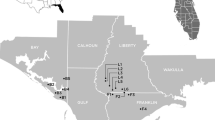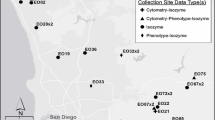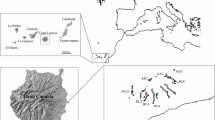Abstract
The southeastern United States and Florida support an unusually large number of endemic plant species, many of which are threatened by anthropogenic habitat disturbance. As conservation measures are undertaken and recovery plans designed, a factor that must be taken into consideration is the genetic composition of the species of concern. Here we describe the levels, and partitioning, of genetic diversity in 17 populations of the rare and threatened Florida endemic, Euphorbia telephioides (telephus spurge). Species-wide genetic diversity was high (Ps = 91%, APs = 3.81, As = 3.57 and Hes = 0.352) as was mean population genetic diversity (Pp = 81%, APp = 2.98, Ap = 2.59 and Hep = 0.320) which ranks it among the highest 10% of plant species surveyed. Partitioning of genetic variation (Gst = 0.106) was low compared to other herbaceous outcrossing perennials indicating high historical gene flow across its limited geographic range. Among population Gst values within the three Florida counties in which it occurs, Gulf (0.084), Franklin (0.059) and Bay Counties (0.033), were also quite low. Peripheral populations did not generally have reduced genetic variation although there was significant isolation by distance. Rarefaction analysis showed a non-significant relationship between allelic richness and actual population sizes. Our data suggest that E. telephioides populations were probably more continuously distributed in Bay, Gulf and Franklin Counties and that their relative contemporary isolation is a recent phenomenon. These results are important for developing a recovery plan for this species.


Similar content being viewed by others
References
Bridges EL, Orzell SL (2002) Euphorbia (Euphorbiaceae) section Tithymalus subsection Inundatae in the southeastern United States. Lundellia 5:59–78
Brody SD (2008) Ecosystem planning in Florida: solving regional problems through local decision-making. MPG Books Ltd, Bodmin, Cornwall. Great Britain
Cole CT (2003) Genetic variation in rare and common plants. Annu Rev Ecol Evol Syst 34:213–237
Delcourt HR, Delcourt PA (1991) Quaternary ecology: a paleoecological perspective. Chapman and Hall, New York
Dobzhansky Th (1937) Genetics and the origin of species. Columbia University Press, New York
Epperson BK, Alvarez-Buylla ER (1997) Limited seed dispersal and genetic structure in life stages of Cecropia obtusifolia. Evolution 51:275–282
Felsenstein J (2005) PHYLIP (Phylogeny Inference Package) version 3.6. Distributed by the author. Department of Genome Sciences, University of Washington, Seattle
Fisher RA (1930) The genetical theory of natural selection. Oxford University Press, UK
Florida natural areas inventory (FNAI) (2007) Telephus spurge element of occurrence spatial data. Florida
Gentry AH (1986) Endemism in tropical versus temperate plant communities. In: Soule ME (ed) Conservation biology, the science of scarcity and diversity. Sinauer Associates, Sunderland, pp 153–181
Hamrick JL, Godt MJW (1989) Allozyme diversity in plant species. In: Brown AHD, Clegg MT, Kahler AL, Weir BS (eds) Plant population genetics, breeding and genetic resources. Sinauer Associates, Sunderland, pp 46–63
Hamrick JL, Linhart YB, Mitton JB (1979) Relationships between life-history characteristics and electrophoretically detectable genetic variation in plants. Ann Rev Ecol Syst 10:173–200
Hans AS (1973) Chromosomal conspectus of the Euphorbiaceae. Taxon 22:591–636
Hiers JK, O’Brien JJ, Will RE, Mitchell RJ (2007) Forest floor depth mediates understory vigor in xeric Pinus palustris ecosystems. Ecol Appl 17:806–814
Jensen JL, Bohonak AJ, Kelley ST (2005) Isolation by distance, web service. BMC Genetics 6: 13. v.3.16 http://ibdws.sdsu.edu/
Kalinowski ST (2004) Counting alleles with rarefaction: private alleles and hierarchical sampling designs. Conserv Genet 5:539–543
Kalinowski ST (2005) HP-Rare 1.0: a computer program for performing rarefaction on measures of allelic richness. Mol Ecol Notes 5:187–189
Li CC, Horvitz DG (1953) Some methods of estimating the inbreeding coefficient. Am J Hum Genet 5:107–117
Manchenko GP (1994) Handbook of detection of enzymes on electrophoretic gels. CRC Press, Ann Arbor
Narbona E, Ortiz PL, Arista M (2002) Functional andromonoecy in Euphorbia Euphorbiaceae). Ann Bot 89:571–577
Nei M (1972) Genetic distance between populations. American Naturalist 106:283–292
Nei M (1973) Analysis of gene diversity in subdivided populations. Proc Natl Acad Sci USA 70:3321–3323
Park KR (2004) Comparisons of allozyme variation of narrow endemic and widespread species of Far East Euphorbia (Euphorbiaceae). Botanical Bulletin of Academia Sinica 45:221–228
Park KR, Elisens WJ (1997) Isozyme and morphological evidence within Euphorbia section Tithymalopsis (Euphorbiaceae). Int J Plant Sci 158:465–475
Peakall R, Smouse PE (2006) GENALEX 6: genetic analysis in excel. Population genetic software for teaching and research. Mol Ecol Notes 6:288–295
Peterson CL, Campbell CC (2007) Seed collection and research on eight rare plants species of the Florida Panhandle region. USFWS grant agreement 401815G173
Pritchard JK, Stephens M, Donnelly P (2000) Inference of population structure using multilocus genotype data. Genetics 155:945–959
Rohlf FJ (2000) Numerical taxonomy and multivariate analysis system version 2.1. Exeter Publishing, New York
Rountree A, Tobe J, Busalacchi J (2005) Report: threatened and endangered species survey. Shallow Reed Site, Gulf County
Rousset F (1997) Genetic differentiation and estimation of gene flow from F-statistics under isolation by distance. Genetics 145:1219–1228
Slapcinsky JL, Gordon DR, Menges ES (2010) Responses of rare plant species to fire in Florida’s pyrogenic communities. Nat Areas J 30:4–19
Smouse PE, Long JC, Sokal RR (1986) Multiple regression and correlation extensions of the Mantel test of matrix correspondence. Syst Zool 35:627–632
Soltis DE, Soltis PS (1993) Molecular data and the dynamic nature of polyploidy. Crit Rev Plant Sci 12:243–273
Soltis DE, Haufler CH, Darrow DC, Gastony GJ (1983) Starch gel electrophoresis of ferns: a compilation of grinding buffers, gel and electrode buffers, and staining schedules. Am Fern J 73:9–27
U.S. Fish and Wildlife Service (1994) Recovery plan: recovery plan for four plants of the lower Apalachicola region, Florida: Euphorbia telephioides (telephus spurge), Macbridea alba (white birds-in-a-nest), Pinguicula ionantha (Godfrey’s butterwort), and Scutellaria floridana (Florida skullcap). U.S. Fish and Wildlife Service southeast region. Panama City Field Office, Panama City
U.S. Fish and Wildlife Service (2007) Euphorbia telephioides (telephus spurge) 5-year review: summary and evaluation. U.S. Fish and Wildlife Service southeast region. Panama City Field Office. Panama City
Walter KS, Gillett HJ (1998) 1997 IUCN Red List of Threatened Plants. Compiled by the world conservation monitoring centre. IUCN:The World Conservation Union, Gland, Switzerland and Cambridge, UK. pp xiv+862
Webster GL (1967) Genera of Euphorbiaceae in the Southeastern Unites States. J Arnold Arboretum 48:303–430
Weeden NF, Wendell JF (1989) Genetics of plant isozymes. In: Soltis DE, Soltis PS (eds) Isozymes in plant biology. Dioscorides Press, Portland, pp 46–72
Weir BS (1996) Genetic data analysis II. Sinauer Associates, Inc., Sunderland
Workman PL, Niswander JD (1970) Population studies on southwestern Indian tribes. II. Local genetic differentiation in the Papago. Am J Hum Genet 22(24):49
Wright S (1922) Coefficients of inbreeding and relationship. Am Nat 56:330–338
Wright S (1951) The genetical structure of populations. Ann Eugen 15:323–354
Acknowledgments
The authors thank C. Deen and the Hamrick lab personnel for assistance in the lab as well as three anonymous reviewers for their helpful comments. Funding for the project was provided by the U.S. Fish and Wildlife Service.
Author information
Authors and Affiliations
Corresponding author
Rights and permissions
About this article
Cite this article
Trapnell, D.W., Hamrick, J.L. & Negrón-Ortiz, V. Genetic diversity within a threatened, endemic North American species, Euphorbia telephioides (Euphorbiaceae). Conserv Genet 13, 743–751 (2012). https://doi.org/10.1007/s10592-012-0323-4
Received:
Accepted:
Published:
Issue Date:
DOI: https://doi.org/10.1007/s10592-012-0323-4




